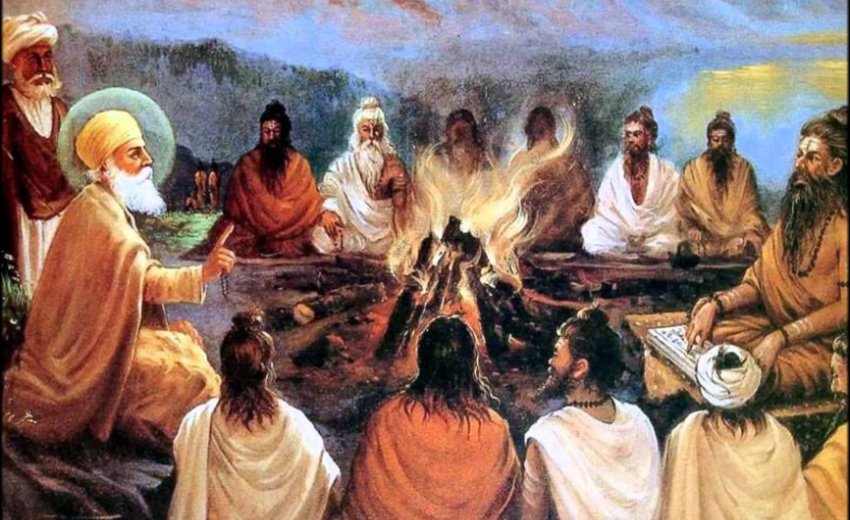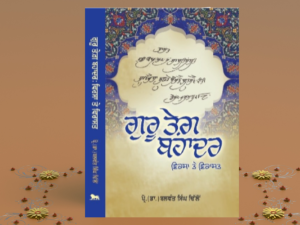The Siddh-Goshti is an inter-religious debate between Siddh-Nath-Yogis and Guru Nanak. Nath-Yogis and Siddhas belonged to Sahajayani sect of Buddhism and held their sway in Punjab. The concepts of Sabad, Nam, Guru, Mind, Sunya and Gurmukh are explained to Siddhas from Sikh view-point. Ultimately, the Guru prevails upon Siddhas explaining them the efficacy of Sahaj-Yoga philosophy of Sikhism.
INTRODUCTION
Guru Nanak, the founder of Sikhism, appears on the Indian scene at a crucial juncture when Hinduism and Islam were confronting each other with Hinduism gasping for breath. The decay of Hindu culture is represented in Asa di var by Guru Nanak [1]. Various other sects who lived and preached in Punjab are also mentioned by Guru Nanak in his bani. Siddhas, Naths and Yogis held their sway in Punjab before the advent of Sikhism. They all belong to the Sahajayani sect of Buddhism or its perverted forms after assimilation into Hindu fold. According to Mahan Kosh [2], there were twelve panths of Nath-cult in Punjab and eightyfour Siddhas, with Guru Gorakh Nath as a leading figure among the Siddhas of Punjab. Siddhas, Naths and Yogis practised various types of asanas (bodily postures), pranayam (breath-control), dharana (concentration), dhyan (meditation) and samadhi (estasis) to gain long life, miraculous powers (siddhis) and liberation (mukti).
Patanjali's Yoga-darshan is one of six schools of Indian philosophy. It was held in great esteem both in the orient and occident. Even today, the western youth has a strong affinity for Indian yoga philosophy and its techniques. Harbhajan Singh Khalsa (Yogi Bhajan) initially achieved a great success in preaching Sikhism in the western hemisphere by employing yoga techniques. In the dialogue between Guru Nanak and Siddhas, yogic terminology has been used in full measure. The reader may refer to some standard text on Indian yogic philosophy/techniques to understand the import of yogic terminology, e.g., ida, pingala, sukhmana, sunya, surti and anhad nad, etc.
During his itineraries, Guru Nanak visited holy places of both Hinduism and Islam. He preached his mission in a simple but forceful manner. In his encounter with Siddhas, Guru Nanak shows his mastery over the art and craft of religious debate. Siddhas posed very philosophical and abstract questions in a quick succession to embarass Guru Nanak, considering him a novice. The Guru's replies were equally pertinent and incisive and ultimately Siddhas felt defeated and dethroned. Guru Nanak used even derogatory language, as quoted by Bhai Gurdas [3], against the leader of Siddhas. The Guru decried the Yogi's cult of first renouncing the world and then cringing before the same house-holders whom they had forsaken, for mere crumbs.
There is no consensus of opinion among the scholars regarding the venue of Siddh- Goshti because there is no indication given by Guru Nanak in his bani. However, Bhai Gurdas, the great Sikh chronicler, had given account of two encounters of Guru Nanak with Siddhas, the first one at Sumeru mountain in the Himalayas [4] and the second one at Achal Batala [5] near Batala town of Punjab. The great debate referred to in Siddh-Goshti took place at Achal Batala after Guru Nanak settled down as a house holder in Kartarpur on the banks of river Ravi. It is obvious from Bhai Gurdas's diction that he had used the Siddhas, Yogis and Naths interchangeably for the same group of ascetics who confronted Guru Nanak about his mission. Bhai Gurdas declares emphatically that Baba Nanak won over the Siddhas during these two encounters with the power of Sabda.
SAHAJ-YOGA VERSUS HATHA-YOGA
All the religions of the world present a model to the civilised man to liberate himself from his conditioned life. To obtain mukti (liberation) from the bonds of worldly life, various disciplines and practices have been prescribed. Hindu religion lays emphasis on Gyan, Karma and Bhakti-yoga. Siddhas relied on Hatha-yoga technique. It is based on the principle of controlling and channelising of prana, man's vital life force, for awakening his latent energy, called Kundalini. Hath-yoga has for its tools, asanas, pranayam, mudras and samadhi. Asanas are such postures of body as help a yogi attain longevity and concentration of mind. Pranayam and samadhi have the potential to throw open gates of vast occult powers known as siddhis. Pranayam refers to breath-control which is practised to awaken Kundalini, which is believed to lie at the lower end of the spinal chord. The major concern of a Hatha-yogi is to awaken the Kundalini or Serpent energy. Hatha-yoga Pradipika elaborates the techniques to be followed by a Hatha-yogi to attain liberation from the cycle of life and death. This is such a complicated and complex system that man is advised to renounce the worldly life and to remain cut off from his social moorings to attain liberation.
Guru Nanak rejected the Hatha-yoga cult of Siddhas and condemned the path of renunciation followed by them. He advocated adoption of house - holder's life of struggle in this world and preached Sahaj-yoga or Nam-yoga. Guru Nanak elaborates the concepts of sabda, nam, guru, sunya, gurmukh etc. to establish the hypothesis of Sahaj-yoga, the Sikh way of life. To a pertinent question of yogi Charpat Nath, Guru Nanak sums up his ideas of worldly life beautifully as follows[6]:
Q. The World is but an unfordable ocean;
How may then one get across it? (St. 4)
A. Lead ye a life detached as does the acquatic fowl on the lake;
Or, much as the lotus flower, which stays free of grime, wherefrom it has sprung. (St.5)
Siddh-Goshti is a remarkable debate on the beliefs, practices and doctrines of the two systems or philosophies; one propounded by the Siddhas and the other by Guru Nanak, the founder of Sikh faith. Philosophical questions concerning the origin of cosmos, life and mind; potency of sabda, need for the guru, nature of Supreme Reality and the predicament of human soul for liberation are answered by Guru Nanak from the Sikh view-point. The concept of Ideal Man (Gurmukh) is propounded by Guru Nanak and almost half of the text is devoted to explain the characteristics of Gurmukh. The queries of Siddhas are answered by Guru Nanak in his own characteristic style demolishing the castle of Siddh-Nath-Yogi cult in Punjab. To cut the story short, we may refer to a few selected queries of Siddhas and replies offered by Guru Nanak during this debate, as follows [7]:
Some typical Questions & Answers
Q.1. Who it is that is unmanifest?
And, who that is redeemed? (St. 12)
A.1. The unmanifest one permeates each heart;
The God-conscious one alone is emancipated. (St. 13)
Q.2. Why have you renounced your home and turned a recluse?
Why have you donned this garb of a mendicant? (St. 17)
A.2. I have turned a recluse in search of a God-conscious person;
I have donned this garb to have a vision of the Lord Divine. (St. 18)
Q.3. What about the pre-cosmos state ?
Prior to it where the Lord of void abide? (St. 21)
A.3. The very thought of the pre-cosmos state lands one in a state of wonderment.
In the profound stillness of the Sunya, the Formless one pervaded in continuum then. (St. 23)
Q.4. What lies at the root of life?
And what is the prime creed of the age?
Of which Guru are you a disciple? (St. 43)
A.4. Pray Sir, air it is that supports all life.
And, the True Guru's message is the creed of the day.
The World is verily the Light of the Lord.
And, mind attuned to it is the recipient thereof. (St.44)
Q.5. Where does the way-ward mind abide?
And, where does the breath-sustaining air reside? (St. 64)
A.5. When the mind attains lasting peace with one's innerself,
The God-conscious one apprehends the Essence of the Primal Being. (St. 65)
Q.6.When the body and the mind were not there where did the soul abide? (St. 66)
A.6. Know ye, O recluse, that when the body and the mind were not there,
The Soul abided detached in its Primal home. (St. 67)
REFERENCES
1. AGGS, M1, P. 463-475.
2. Nabha, Bhai Sahib Bhai Kahn Singh, 1960 (2nd ed.) Gursabad-Ratnakar (Mahan Kosh), P. 640
3. Bhai Gurdas, Var I, Pauri 28.
4. Bhai Gurdas, Var I, Pauri 40.
5. Bhai Gurdas, Var I, Pauri 36.
6. AGGS, M1, P, 938.
7. Guru Nanak's Siddh-Goshti, Translated by Piar Singh, G.N.D. University, Amritsar, 1996(AGGS pp.938-946).
End Note: AGGS denotes Aad Guru Granth Sahib. Publishers: Shiromani Gurdwara Parbandhak Committee (SGPC), Amritsar. M 1 refers to Guru Nanak, P refers to Page number of the AGGS, the Holy Book of Sikh Religion.






